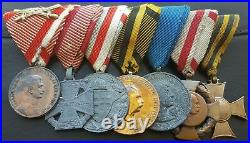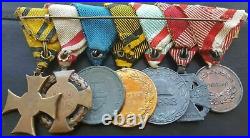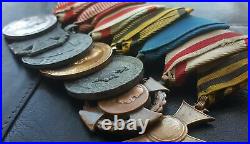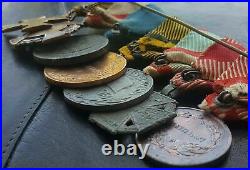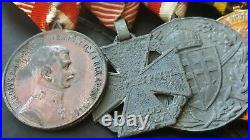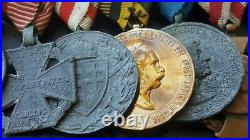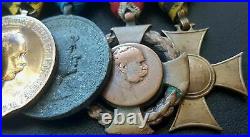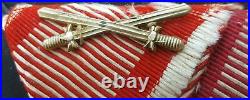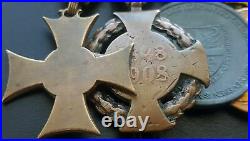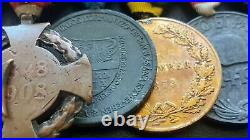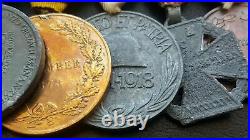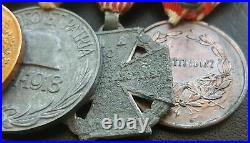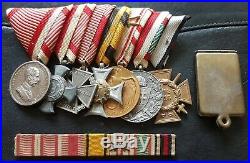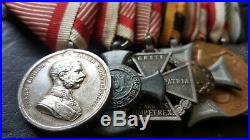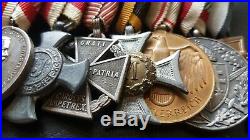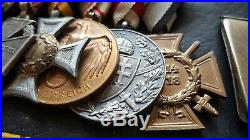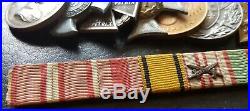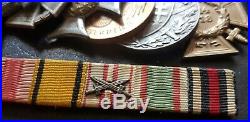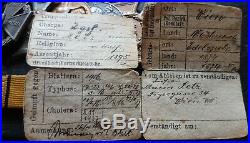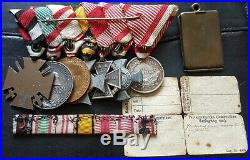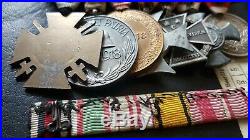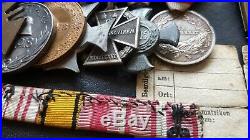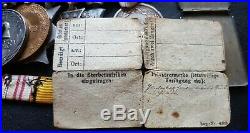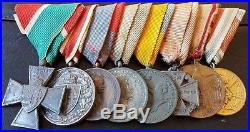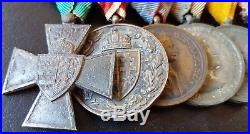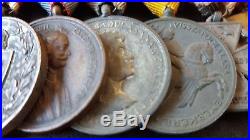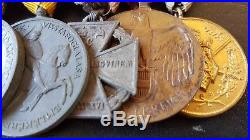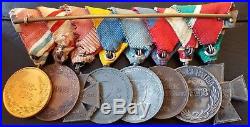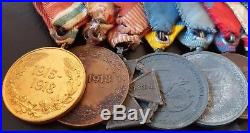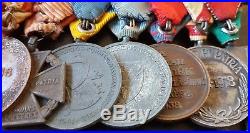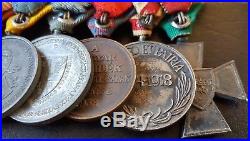Original WW1 / WW2 Austro-Hungarian Empire / Hungarian Kingdom parade mounted medal grouping: Austro-Hungarian Empire / Bronze Karl IV. Bravery Medal (late war bronzed zinc example), Austro-Hungarian Empire Karl Troop Cross, Hungarian Kingdom Commemorative Medal of the World War for combatants (rare zinc example), Austro-Hungarian Empire General Campaign Medal , Hungarian Kingdom / Commemorative Medal Liberation of Transylvania – 1940, Austro-Hungarian Empire / Jubilee Cross – 1908 & Austro-Hungarian Empire Mobilisation Cross , IN WORN CONDITION, GENUINE RIBBONS, PERFECTLY WORKING PIN DEVICE, ALL MEDALS ARE WORN & LOST PART OF THEIR FINISH, CLEARLY A WELL WORN MEDAL GROUPING. HISTORY OF THE AWARDS. Since 1809 this was known as the Bravery Medal or Tapferkeitsmedaille. On the 19th August 1848 Kaiser Ferdinand divided the Silver Bravery Medal into two classes – a First and a Second Class. The 2nd Class Medal being a smaller version with a diameter of 31mm. On the 14th February 1915 Kaiser Franz Joseph introduced the Bronze Medal which was the same size as the 2nd Class Silver. Unlike the three senior awards, the Bronze Medal could be awarded to NCOs and Private Soldiers of allied armies. The Bravery Medals displayed the reigning Kaiser’s head on the obverse. In the case of Franz Joseph, he was depicted in a Marshals’ uniform and the following inscription was placed around the outer edge of the medal: FRANZ JOSEPH I. OESTERREICH (Franz Joseph I, by the grace of God Emperor of Austria). The obverse showed six crossed regimental colours surrounded by a laurel wreath and the motto: “Der Tapferkeit”. The diameter of the Gold and large Silver Medal was 40mm. The ribbon of the Bravery Medal was the same white and red ribbon as the Military Merit Cross. An Imperial Decree of the 29th November 1915 introduced bars for repeat awards and these took the form of an 8mm wide smooth rustless iron bar. The recipient of a Bravery Medal was entitled to a lifelong pension and as ordered by the “Zirkularverordnung” of 18th September 1914 the sums were as follows with effect from the1st October 1914: Golden Bravery Medal – 30 Crowns per month, Silver Bravery Medal 1st Class – 15 Crowns per month, Silver Bravery Medal 2nd Class – 7.50 Crowns per month. With effect from the 4th April 1917 as published in the Normal-Verordnungsblatt Nr. 18 new versions of the Medal were introduced bearing the new Kaiser’s portrait and the inscription: CAROLVS D. The reverse was altered to bear the Motto “FORTITVDINI”. A further change was the newly introduced eligibility for Commissioned Officers to be awarded the Golden and Silver Bravery Medals with effect from the 15th of September 1917 although the Officers’ Awards did not attract the monthly pension. The Officers’ version was distinguished by the addition to the triangular ribbon of a gold or silver “K”. Although the awards to NCOs and Men were delegated to Army Commanders in the field those of the Golden and Silver Medals for Officers remained an Imperial prerogative. Karl Troop Cross (Karl Truppenkreuz) was instituted on 13 December 1916 by Emperor Karl I of Austria-Hungary. The cross was awarded until the end of the First World War to soldiers of the Austro-Hungarian Army , regardless of rank, who had been with a combatant unit for at least twelve weeks and who had actually served at the front. The medal is of zinc and consists of a cross pattée resting on a laurel wreath. The obverse bears the Latin inscription “GRATI PRINCEPS ET PATRIA, CAROLVS REX”, (A grateful prince and country, Karl, Emperor and King). The reverse shows the Austrian and Hungarian Imperial crowns above the letter “C” (for Carolus) with the inscription “VITEM ET SANGVINEM”, (With life and blood) and the date MDCCCCXVI, (1916). The cross was worn on the left chest from a red ribbon with alternate red-white side strips towards each edge. A total of 651,000 were awarded. Commemorative War Medal (Háborús Emlékérem) – Instituted on May 26, 1929 by the Hungarian regent Admiral Miklós Horthy de Nagybánya to commemorate Hungarian subjects who participated and fell during the Great War. Medals statute was finalized only on November 14, 1929 and gazetted two days later in the official publication of the Hungarian Ministry of Defence, Honvédségi Közlöny (Military Bulletin). Awards presentation started early next year. Commemorative War Medal was awarded to military personnel regardless of rank and status, frontline soldiers and non-combatants, wounded and disabled war veterans, medical personnel and awardees of the Red Cross badges, ex-POWs, relatives of KIA. Civilians who worked at homefront and those participated in Hungarian Soviet Republic defeat in summer and fall 1919 were also eligible for this medal. Documents verifying participation in the Great War had to be presented to military authorities and in case of their absence one had to enlist support of two reliable witnesses. Central Powers military personnel who fought alongside Hungarians during the Great War had to apply for the medal. Foreigners received award in envelope that also contained certificate and miniature after verification and reimbursement worth 15 peng. Nevertheless levy could have been lifted by a decree of the Minister of defence due to exceptional circumstances. Outlets distributed medals wrapped in filigree exactly as they came from the mint. No boxes or envelopes were provided. Commemeorative War medal was instituted in two classes for frontline soldiers and war participants, i. These variants different in obverse and reverse design as well as in ribbon colors. In case an applicant was eligible for both classes he received Commemorative War medal for frontline soldiers. Medal was designed by famous Hungarian sculptor Kisfaludi Strobl Zsigmond (01.07.1884 14.08.1975) who was Great War participant himself. Circular 37 mm medal with laterally-pierced loop for ribbon suspension was made of bronze with silver finish and was 3 mm thick. It was worn on the left breast suspended by the traditional Austrian triangular ribbon while women wore it on a bow. Commemorative War medal for frontline soldiers (Haborús Emlékérem kardokkal és sisakkal). Obverse had crowned arms of Hungary imposed on crossed swords within a wreath of laurel and oak. Latin inscription Pro Deo Et Patria (For God and Fatherland) was on the upper part while two laurel leaves at the bottom tied at the base by a ribbon tie. 40 mm wide ribbon of a Commemorative War medal for frontline soldiers was white with two wide vertical red stripes close to edges and thin horizontal green stripes placed between red ones. Special combat clasp in form of two silvered crossed swords could be applied to the ribbon bar. Commemorative War medal for noncombatants (Haborús Emlékérem kardok és sisak nélkül) Obverse had crowned arms of Hungary within a wreath of laurel and oak. Crossed swords were missing. Steel helmet image was missing. 40 mm wide ribbon of a Commemorative War medal for noncombatants was white with two wide red stripes close to edges and two wide green stripes between them. Miniatures of this medal with a wide clip on reverse were also issued, their design followed obverse of the respective class. General Campaign Medal (Kriegsmedaille) was instituted by the Emperor of the Austro-Hungarian Empire Franz Joseph I (18.08.1830-21.11.1916) on December 02, 1873, i. On the day the celebrations in conjunction with the 25th jubilee of his enthronement were held. Initially Kriegsmedaille was awarded to servicemen on active military service who entered the Army since December 02, 1848, the day the head of the Dual Monarchy ascended to the Austrian throne, and who participated in at least one battle since that year. Holders of the following Austrian medals were automatically eligible for decoration with the Kriegsmedaille: Commemorative Medal for Defence of Tyrol 1848 (Denkmünze an die Tiroler Landesverteidigung von 1848), Commemorative Medal for the 1864 Military Campaign against Denmark (Erinnerungs-Medaille an den Feldzug 1864 gegen Dänemark), Commemorative Medal for Defence of Tyrol 1866 (Denkmünze an die Tiroler Landesverteidigung von 1866) and Prague Home Guard Medal 1866 (Prager Bürgerwehrmedaille von 1866). Statute of the Kriegsmedaille was changed later on and it was made a decoration for military personnel who took part in subsequent campaigns. Thereupon Kriegsmedaille was issued to those who took part in suppression of the insurrections in Bosnia-Herzegovina and South Dalmatia in 1882. The latter comprised of Russia, Germany, Austria-Hungary, the United Kingdom, France, Italy, Japan and the USA. An obverse showed laurelled bust of Franz Joseph I facing right and circumscribed with 5 mm capital letters Franz Joseph I, Emperor of Austria, King of Bohemia, etc. Apostolic King of Hungary. An inscription is separated by a small six-pointed or, rarely, five-pointed star at the bottom. Two types of an obverse are known to exist, differing in spelling of the words Emperor, Austria, King and Bohemia: Franz Josef I. König n and Franz Josef I. Type of spelling, i. Utilization of diacritic letters with umlaut or digraphs, depended on linguistic preferences. Thus, the former were characteristic of the German language, while the latter to the Latin. Most medals had thin inner ring just below that inscription, while some lacked it. A reverse bore the date of institution of Kriegsmedaille, ber 1873 executed in three rows in capital letters and encircled by a wreath made of olive branch at the left and of oak branch at the right. The wreath is tied with a ribbon at the bottom. Once again, two types of the medal differed in the spelling of the date: ber 1873 (Latin) and ber 1873 (German). The latter type is less common, in fact and is said to be manufactured after 1900. Slight variations differing in a shape of 2 (straight and fashioned numerals) are known to exist as well. Thereby, on the basis of combination of German and Latin letters three variations of Kriegsmedaille could be marked out: Latin obverse and reverse, German obverse and reverse, German obverse and Latin reverse. Quite unusual type of the War Medal had no image on its reverse at all, save for chequered surface. Those medals dating beginning of the XX century were produced for wearing by officers with white summer tunics. Absence of an image at reverse precluded inevitable rubbing of metal against cloth, thus leaving tunic clean and preventing dark indelible stains. In fact, reverse was made attachable and was manufactured of nonmetal material, e. Patent for that invention was issued to the Belgian chemist Leo Hendrik Baekeland (14.11.1863-23.02.1944) in 1909. In most cases the edge of Kriegsmedaille was plain, though some specimen bore mintmarks, e. As the War Medal was manufactured for half a century, from 1873 till 1920s and the number of awards was quite numerous, many variations of Kriegsmedaille existed. They differed in size, weight, metal, shape of ring, presence of mintmarks, as well as in slight distinctions of obverse and reverse design. Kriegsmedaille had a circular shape, measured 36-37,5 mm in diameter and was made either of gilt bronze or gilt bronzed zinc. The War Medal was worn suspended from a traditional triangular silk ribbon of Habsburg colors: 40 mm wide yellow ribbon with two black 4,5 mm wide stripes closer to both edges and 22 mm long thin horizontal black stripes in-between. To make an article complete, table medal of the similar design is worth being mentioned here. It was manufactured of light bronze and was 37 mm in diameter. Commemorative Medal for the Liberation of Transylvania (Erdélyi Emlékérem), 1940 Circular medal in Kriegsmetall (zinc alloy) with laterally-pierced loop for ribbon suspension; the face with the head of King Mátyás Corvinus circumscribed ERDÉLYI RÉSZEK FELSZABADULÁSÁNAK EMLÉKÉRE (Medal for the Liberation of Part of Transylvania); the reverse with the arms of Transylvania circumscribed MÁTYÁS KIRÁLY SZÜLETÉSÉNEK 500 ÉVFORDULÓJÁN (King Mátyás 500th Anniversary of his Birthright) and inscribed around the rim VITÉZ NAGYBÁNYAI HORTHY MIKLÓS KORMÁNYZÓ ORSZÁGLÁSÁNAK XX ÉVÉBEN (In the 20th Year of the Regency of Valiant Miklós Horthy de Nagybányai). The medal was instituted on 1 October 1940 to mark the return of part of Transylvania to Hungary. At the end of World War I, Hungary lost almost three-quarters of its territory, amongst them many areas with large Hungarian populations, including Transylvania. In mid-1940, with Romania under pressure from the Soviet Union and Bulgaria, Hungary lodged a claim to Transylvania. Germany and Italy led arbitration at Vienna and on 30 August Romania ceded approximately 43,500 square kilometres of territory and almost 2,400,000 people in northwest Transylvania to Hungary. In 1479 to 1483 he retook Transylvania from the Ottoman Turks and is revered in Hungary as a national hero. The 1908 Military Jubilee Cross (1908 Militär-Jubiläumskreuz or the 1908 Katonai Jubileumi Kereszt) was instituted on 10 August 1908 (published 18 August 1908) to commemorate the 60th Anniversary of the rule of Kaiser Franz Joseph I which occurred on 2 December 1908. In the case of multiple qualification for one of the 3 various Jubilee awards, this award was restricted to only one per person. The military version was considered the highest, the civil was the middle (exactly the same as the military version but for a solid red ribbon), while the court version was the lowest which was quite a change from the 1898 Jubilee awards! It was also awarded to all those on duty on 2 December 1908 on a non-professional military status who had received a minimum of 2 years of military training (specifically: students of Officer Candidate Schools from the 2nd Class and higher and conscript candidates for any reserve rank who were in their 2nd or higher year of service). On 31 December 1914 (published 6 January 1915), Kaiser Franz Joseph I ordered that all officers and officials of the Reserve (or any other similar status) who have participated in the current war and who had already possessed the status of an officer (or official) on 2 December 1908 and had not received the 1908 Military Jubilee Cross should now receive it. The bronze gilt alloy medal is cross shaped ca. 36 mm x 42 mm and surrounded by a laurel wreath. Within the obverse center of the cross is a circle ca. 27 mm with the bust of Kaiser Franz Joseph I. At the 8:00 to 11:00 position is FRANC. At first glance, the entire design appears to be struck off-centered but this design was purposely incorporated. The reverse is plain (except for the wreath) with a thick 1848 1908 centered in a 2 line inscription. The medal is almost 4 mm at the thickest point and tapers to the ends of the cross. It is suspended from a thick barrel type suspension which is part of the struck medal and has a hole bored through for the suspension ring. The suspension ring is usually of the same metal as the medal but the alloy varies. The tri-fold military silk ribbon (40 mm wide) is white with a narrow red stripe (5 mm wide) 3 mm from each end. Note that various ribbons are often used on this award but only the solid red (Civilian Jubilee Medal) was ever additionally awarded, the remainder being fantasy ribbons. The original ribbon was woven silk with a very distinctive weft – most modern ribbons are a poly based material and some have printed coloring rather than woven. The original grommet and hook device was of thin fine brass and very tightly affixed – almost all show various degrees of suspension ring wear to the internal ribbon. Commemorative Cross for Mobilisation (Mobilisierungs-Erinnerungskreuz), 1912-13 Gilt bronze Leopold cross with loop for ribbon suspension; the face with a circular central medallion bearing the dates 1912 1913; the reverse plain; gilding now largely absent; on correct, possibly replaced ribbon. The medal was created in 1913 and awarded to those Austro-Hungarian forces that had been mobilised as a precautionary measure during the Balkan Wars between an alliance of Bulgaria, Greece, Montenegro and Serbia on the one hand and Ottoman Turkey on the other. Austria did not intervene in the wars but they led to Turkey being largely thrown out of Europe and a much-strengthened of Serbia, making Austria more nervous of her Slav neighbour and laying the ground for the outbreak of World War I following the assassination of Archduke Franz-Ferdinand in Sarajevo on 28 June 1914 and Austrias declaration of war on Serbia on 18 July 1914. The item “9454 Austro-Hungarian Empire Hungarian Kingdom mounted medal grouping WW1″ is in sale since Wednesday, March 31, 2021. This item is in the category “Collectables\Militaria\World War I (1914-1918)\Medals/ Ribbons”. The seller is “a..anderson” and is located in ST. ALBANS. This item can be shipped worldwide.
Archive for the austro-hungarian Category
Original WW1 Austro-Hungarian Empire medal grouping. Parade mounted medal group (intact pin device, good ribbons, very nice group). Austro-Hungarian Empire / Silver Bravery Medal Franz Joseph I. Austro-Hungarian Empire / Iron Cross of Merit. Austro-Hungarian Empire / Karl Troop Cross. Austro-Hungarian Empire / Military Service Cross for 6 Years’ Service. Austrian War Commemorative Medal With Swords. Hungarian War Commemorative Medal for Combatants. German Honour Cross With Swords. Matching ribbon bar for the awards above. Dog tag in genuine brass / copper holder. HISTORY OF THE AWARDS. Since 1809 this was known as the Bravery Medal or Tapferkeitsmedaille. On the 19th August 1848 Kaiser Ferdinand divided the Silver Bravery Medal into two classes – a First and a Second Class. The 2nd Class Medal being a smaller version with a diameter of 31mm. On the 14th February 1915 Kaiser Franz Joseph introduced the Bronze Medal which was the same size as the 2nd Class Silver. Unlike the three senior awards, the Bronze Medal could be awarded to NCOs and Private Soldiers of allied armies. The Bravery Medals displayed the reigning Kaiser’s head on the obverse. In the case of Franz Joseph, he was depicted in a Marshals’ uniform and the following inscription was placed around the outer edge of the medal: FRANZ JOSEPH I. OESTERREICH (Franz Joseph I, by the grace of God Emperor of Austria). The obverse showed six crossed regimental colours surrounded by a laurel wreath and the motto: “Der Tapferkeit”. The diameter of the Gold and large Silver Medal was 40mm. The ribbon of the Bravery Medal was the same white and red ribbon as the Military Merit Cross. An Imperial Decree of the 29th November 1915 introduced bars for repeat awards and these took the form of an 8mm wide smooth rustless iron bar. The recipient of a Bravery Medal was entitled to a lifelong pension and as ordered by the “Zirkularverordnung” of 18th September 1914 the sums were as follows with effect from the1st October 1914: Golden Bravery Medal – 30 Crowns per month, Silver Bravery Medal 1st Class – 15 Crowns per month, Silver Bravery Medal 2nd Class – 7.50 Crowns per month. With effect from the 4th April 1917 as published in the Normal-Verordnungsblatt Nr. 18 new versions of the Medal were introduced bearing the new Kaiser’s portrait and the inscription: CAROLVS D. The reverse was altered to bear the Motto “FORTITVDINI”. A further change was the newly introduced eligibility for Commissioned Officers to be awarded the Golden and Silver Bravery Medals with effect from the 15th of September 1917 although the Officers’ Awards did not attract the monthly pension. The Officers’ version was distinguished by the addition to the triangular ribbon of a gold or silver “K”. Although the awards to NCOs and Men were delegated to Army Commanders in the field those of the Golden and Silver Medals for Officers remained an Imperial prerogative. The cross was instituted on 1 April 1916 in two grades Iron with and without Crown as a need had been perceived for a grade below the existing Gold and Silver to reward the many people of lower ranks performing exceptional acts and services, especially in the support and auxiliary services. Karl Troop Cross (Karl Truppenkreuz) was instituted on 13 December 1916 by Emperor Karl I of Austria-Hungary. The cross was awarded until the end of the First World War to soldiers of the Austro-Hungarian Army , regardless of rank, who had been with a combatant unit for at least twelve weeks and who had actually served at the front. The medal is of zinc and consists of a cross pattée resting on a laurel wreath. The reverse shows the Austrian and Hungarian Imperial crowns above the letter “C” (for Carolus) with the inscription “VITEM ET SANGVINEM”, (With life and blood) and the date MDCCCCXVI, (1916). The cross was worn on the left chest from a red ribbon with alternate red-white side strips towards each edge. A total of 651,000 were awarded. Military Long Service Cross for non-commissioned officers and other ranks, III class for 6 years service Militärdienstzeichen für Unteroffiziere und Mannschaften, 3. The Decoration was instituted on 12 March 1890 to reward long and faithful service in the Austro-Hungarian armed forces and was issued in different versions for officers, for non-commissioned officers and for other ranks and for completion of various periods of service. This example is of the fourth and last version for other ranks on completion of 6 years loyal service, awarded from 1913 until the dissolution of the Austro-Hungarian Empire at the end of World War I in November 1918. Austrian War Commemorative Medal (Kriegserinnerungsmedaille) Awarded to all who served in the First World War. This medal was instituted on 21 december 1932 and on 10 November 1933 gilt crossed swords were decreed. These were to be attached to the medal’s ribbon for those who served under fire at the front, wounded and POW who had behaved with honour. The obverse depicts an eagle with wings opened downwards, standing on an upright shield with the Austrian weapon. Along the lower rim are the words “FÜR ÖSTERREICH” (For Austria). Hungarian Commemorative Medal of the World War – Awarded “with helmet and swords” to soldiers and other combattants or “without helmet and swords” to all other war participants or to the nearest relative of a soldier. This medal was instituted on 26 May 1929 by the Regent, Admiral Horthy. The obverse shows the weapon shield of Hungary surmounted by a crown and, if so awarded, with swords underneath the shield. In case of the award “without helmet and swords”, the ribbon is white with green-red-white side stripes. German Cross of Honor, a. Hindenburgkreuz, Frontkämpferehrenkreuz (Ehrenkreuz des Weltkrieges 1914/1918) – Ehrenkreuz des Weltkrieges 1914/1918 was instituted on July 13, 1934 by the President Generalfeldmarshall Paul von Hindenburg aiming to commemorate all those who fought and fell during the Great War and therefore was nicknamed Hindenburg Cross. Cross of Honor was awarded to frontline veterans and non-combatants German citizens and Germans who lost their citizenship due to the Versailles Peace Treaty as well as to relatives of the fallen soldiers their widows and parents. Thus it aim was to reinforce pride not only in veterans but also military personnel of German Armed forces. Cross of Honor was instituted in three classes: 1. Cross of Honor for frontline soldiers (Ehrenkreuz für Frontkämpfer). It was awarded only for the military personnel of the Imperial Army and Navy who had engaged the enemy in frontline combat. Cross of Honor for war participants, i. Non-combatants (Ehrenkreuz für Kriegsteilnehmer). It was awarded to military auxiliary personnel such as administrators and medics, as well as to civilians state officials, etc. Cross of Honor for next-of-kin (Ehrenkreuz für Hinterbliebene). It was issued to widows and parents of those who were killed or died during WWI or were missing in action. Award was issued after an application accompanied by a prove of wartime service or loss of a relative was approved by the authorities, the Reichsminister of interior being in charge of the distribution of crosses. Cross of Honor was handed personally to the active military personnel and sent by post to veterans and civilians. Ehrenkreuz des Weltkrieges was created by Eugene Godet who received commission from the Reich Chancellery and its design was based on that of the Prussian Kriegsdenkmünze für die Feldzüge 1870/1871 Kriegsdenkmünze für die Feldzüge 1870/1871 reverse. It had a form of an equilateral 37×37 mm Teutonic cross with a 1 mm raised edge line and a recessed field. Two dates referring to the Great War were placed over each other in the central medallion 1914 and 1918. The upper arm of the cross had a 1,5-2 mm ribbon ring through which a ribbon loop ran. Three classes of the Honor Cross differed by the following details. Cross of Honor for frontline soldiers made of bronze or bronzed iron had a wreath of laurels on the center, tied at the base by a ribbon tie with the ends extending to the lower arm of the cross. The wreath was composed of five bunches of three leaves on each side, with a pair of laurel berries at each joint. A pair of 41 mm crossed swords were placed through the arms of the cross. Tricolor 25-30 mm ribbon featured central red stripe and black and white stripes on both sides accompanied by thin black stripes closer to both edges. Sometimes a crossed swords gilt device was worn on the ribbon. Cross of Honor for war participants made of bronze or bronzed iron was of a nearly similar design but had a wreath of oak leaves and lacked swords. Its ribbon was similar to that of the Cross of Honor for frontline soldiers. Cross of Honor for next-of-kin was similar to the Cross of Honor for war participants but was finished in black and its ribbon colors were inverted, i. Central red stripe and white and black stripes on both sides accompanied by thin white stripes closer to both edges. Its worth mentioning here that though award documents for the Cross of Honor for next-of-kin were of two different types (Ehrenkreuz für Witwen and Ehrenkreuz für Eltern) the award itself was only of one type as described above. The rarest type of the Cross of Honor for next-of-kin was made of iron and had a horizontal pin and catch on its reverse instead of ribbon ring that was missing. All three classes of the award had a flat reverse with makers mark. Ehrenkreuz des Weltkrieges was made of bronze or iron. The Cross of Honor was worn mounted as part of a group or on the ribbon bar. The award ranked above service and occupation medals but below combat related awards. Number of awards: Ehrenkreuz für Frontkämpfer 6,202,883 pieces, Ehrenkreuz für Kriegsteilnehmer 1,120,449 pieces, Ehrenkreuz für Hinterbliebene 345,112 pieces issued to widows with Ehrenkreuz für Witwen award document and Ehrenkreuz für Hinterbliebene 372,950 pieces issued to parents who lost their sons with Ehrenkreuz für Eltern award document. The item “8369 Austro-Hungarian Empire mounted medal grouping WW1 ribbon bar dog tag” is in sale since Friday, May 24, 2019. This item is in the category “Collectables\Militaria\World War I (1914-1918)\Medals/ Ribbons”. The seller is “a..anderson” and is located in Abbots Langley. This item can be shipped worldwide.
- Country/ Organization: Germany
- Type: Medals & Ribbons
- Conflict: World War I (1914-1918)
- Era: 1914-1945
Original Austro-Hungarian Empire / Hungary Kingdom mounted medal group – WW1 / WW2: Hungarian National Defence Cross, Hungarian War Commemorative Medal Without Swords & Helmet. Hungarian War Commemorative Medal for Liberation of Transylvania, Hungarian War Commemorative Medal for Liberation of Upper Hungary, Hungarian War Commemorative Medal for Liberation of Southern Hungary. Austrian War Commemorative Medal. Bulgarian War Commemorative Medal. VERY NICE WORN CONDITION, BEAUTIFUL GROUP, PERFECT PIN DEVICE, ALL RIBBON ARE GENUINE, THE WW1 MEDALS’ RIBBONS LOOK MORE WORN BUT STILL OK. HISTORY OF THE AWARDS. National Defence Cross (Nemzetvédelmi Kereszt), 1940 – Silvered metal cross pattée, the arms stippled, with laterally-pierced ball suspension; the face with the arms of Hungary imposed centrally; the reverse with a central escutcheon inscribed A HAZÁÉRT (for the Homeland) and dated 1940′. The Cross was instituted 11 December 1940 with the intention initially of rewarding those who had resisted and defeated the Communist regime of Bela Kun in 1919 and latterly those who loyally served the Regent of Hungary and fought subversive elements during World War II. Hungarian Commemorative Medal of the World War – Awarded “with helmet and swords” to soldiers and other combattants or “without helmet and swords” to all other war participants or to the nearest relative of a soldier. This medal was instituted on 26 May 1929 by the Regent, Admiral Horthy. The obverse shows the weapon shield of Hungary surmounted by a crown and, if so awarded, with swords underneath the shield. In case of the award “without helmet and swords”, the ribbon is white with green-red-white side stripes. Commemorative Medal for the Liberation of Transylvania (Erdélyi Emlékérem), 1940 Circular medal in Kriegsmetall (zinc alloy) with laterally-pierced loop for ribbon suspension; the face with the head of King Mátyás Corvinus circumscribed ERDÉLYI RÉSZEK FELSZABADULÁSÁNAK EMLÉKÉRE (Medal for the Liberation of Part of Transylvania); the reverse with the arms of Transylvania circumscribed MÁTYÁS KIRÁLY SZÜLETÉSÉNEK 500 ÉVFORDULÓJÁN (King Mátyás 500th Anniversary of his Birthright) and inscribed around the rim VITÉZ NAGYBÁNYAI HORTHY MIKLÓS KORMÁNYZÓ ORSZÁGLÁSÁNAK XX ÉVÉBEN (In the 20th Year of the Regency of Valiant Miklós Horthy de Nagybányai). The medal was instituted on 1 October 1940 to mark the return of part of Transylvania to Hungary. At the end of World War I, Hungary lost almost three-quarters of its territory, amongst them many areas with large Hungarian populations, including Transylvania. In mid-1940, with Romania under pressure from the Soviet Union and Bulgaria, Hungary lodged a claim to Transylvania. Germany and Italy led arbitration at Vienna and on 30 August Romania ceded approximately 43,500 square kilometres of territory and almost 2,400,000 people in northwest Transylvania to Hungary. In 1479 to 1483 he retook Transylvania from the Ottoman Turks and is revered in Hungary as a national hero. Commemorative Medal for the Liberation of Upper Hungary (Felvidéki Emlékérem), 1938 Circular bronze medal with laterally-pierced loop for ribbon suspension; the face with the head and shoulders portrait of Francis II Rákóczi in armour facing right, circumscribed PRO PATRIA ET LIBERTATE RÁKÓCZI (For Fatherland and Liberty Rákóczi); the reverse inscribed A MAGYAR FELVIDÉK FELSZABADULÁSÁNAK EMLÉKÉRE (Medal for the Liberation of Upper Hungary). The medal was instituted on 4 November 1938. At the end of World War I, Hungary lost almost three-quarters of its territory, amongst them many areas with large Hungarian populations, including areas of southern Slovakia and southern Carpathian Rus. The Munich Agreement between Germany, Britain, France and Italy dealt not only with the question of the Sudeten Germans but also called for a settlement of Hungarian claims on this Czechoslovak territory. German and Italian arbitration in Vienna led to an imposed settlement on 2 November 1938 by which almost 12,000 square kilometres of territory and over a million people were transferred to Hungary. The award was annulled after World War II and the territory divided between Slovakia and the Ukraine. He is revered in Hungary as a national hero. Commemorative Medal for the Liberation of Southern Hungary (Délvidéki Emlékérem), 1941 Circular medal in Kriegsmetall (zinc alloy) with laterally-pierced loop for ribbon suspension; the face with John Hunyadi circumscribed MAGYAR DÉLVIDÉK VISSZAFOGLALÁSA EMLÉKÉRE (Medal for the Reoccupation of Southern Hungary); the reverse with the arms of Southern Hungary circumscribed VITÉZ NAGYBÁNYAI HORTHY MIKLÓS KORMÁNYZÓSÁGÁNAK XXII ÉVÉBEN (In the 22nd Year of the Regency of Valiant Miklós Horthy de Nagybányai). The medal was instituted on 11 April 1941 to mark the return of Southern Hungary to Hungary. At the end of World War I, Hungary lost almost three-quarters of its territory, amongst them many areas with large Hungarian populations, including Southern Hungary. Karl Troop Cross (Karl Truppenkreuz) was instituted on 13 December 1916 by Emperor Karl I of Austria-Hungary. The cross was awarded until the end of the First World War to soldiers of the Austro-Hungarian Army , regardless of rank, who had been with a combatant unit for at least twelve weeks and who had actually served at the front. The medal is of zinc and consists of a cross pattée resting on a laurel wreath. The reverse shows the Austrian and Hungarian Imperial crowns above the letter “C” (for Carolus) with the inscription “VITEM ET SANGVINEM”, (With life and blood) and the date MDCCCCXVI, (1916). The cross was worn on the left chest from a red ribbon with alternate red-white side strips towards each edge. A total of 651,000 were awarded. Austrian War Commemorative Medal (Kriegserinnerungsmedaille) Awarded to all who served in the First World War. This medal was instituted on 21 december 1932 and on 10 November 1933 gilt crossed swords were decreed. These were to be attached to the medal’s ribbon for those who served under fire at the front, wounded and POW who had behaved with honour. The obverse depicts an eagle with wings opened downwards, standing on an upright shield with the Austrian weapon. Along the lower rim are the words “FÜR ÖSTERREICH” (For Austria). The medal is 3.6mm thick and thus of Swiss manufacture. The medal was created by decree on 9 December 1933 and awarded to all participants then living in World War I, both military and civilian, until 31 December 1939. The medal could be awarded to military from the Central Powers and to foreign citizens; in the event the largest such group was German military. Bulgaria felt a great sense of grievance following the loss of territory at the conclusion of the second Balkan War in 1913. When Germany offered to restore all of the lands she had been promised in 1878, Bulgaria, which had the largest army in the Balkans, declared war on Serbia in October 1915. In return, Britain, France and Italy then declared war on Bulgaria. After initial victories, the war became unpopular because of food and other shortages and the revolution in Russia in 1917 had a profound effect on Bulgarian sentiment. When the Allies finally broke out of the Salonika pocket, Bulgaria sued for peace and King Ferdinand I abdicated in favour of his son who became King Boris III. The Treaty of Neuilly that concluded the war took significant territory from Bulgaria and imposed severe restrictions on the future size of her armed forces. The item “7722 Austro-Hungarian mounted medal group WW1 WW2 Defence Cross Karl Troop” is in sale since Thursday, April 12, 2018. This item is in the category “Collectables\Militaria\World War I (1914-1918)\Medals/ Ribbons”. The seller is “a..anderson” and is located in Abbots Langley. This item can be shipped worldwide.
- Type: Medals & Ribbons
- Era: 1914-1945
- Conflict: World War I (1914-1918)
- Country/ Organization: Germany
